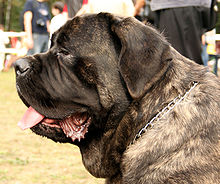This article includes a list ofgeneral references,butit lacks sufficient correspondinginline citations.(August 2011) |
Adewlapis a longitudinal flap ofskinor similar flesh that hangs beneath thelower jaworneckof manyvertebrates.More loosely, it can be various similar structures in the neck area, such as those caused by adouble chinor the submandibularvocal sacof afrog.More generally, it can be any hanging mass of skin, such as a fold of loose skin on an elderlyperson's neck, or thewattleof abird.Dewlaps can be considered as acaruncle,defined as "a small, fleshyexcrescencethat is a normal part of an animal's anatomy ".[1]

Etymology
editThe word is first attested in the mid 1300s asdewelappe( "fold of skin that hangs from the throat of oxen andkine"), fromlappe( "loose piece", fromOld Englishlæppa), but the first element*dew(e)-is of nebulous origin and meaning; it probably was altered byfolk etymologywith "dew".Old English hadfræt-læppain the aforementioned sense (andMiddle Englishfresh-lappe). There also seems to be acognatetoDanish dialectaldoglæp( "flap of skin that sweeps dew from grass, especially on the neck of anox"),[2]but this might be a parallel independent development.
From the 1580s onward, it was applied to the fleshy fold orwattleof aturkeyand also to a flaccid, elderly human throat.[3]
Mammals
editMany mammals such as dogs,rabbitsandmoosepossess dewlaps. Inzebucattle, the dewlap is colloquially known as the "briefcase folds".[citation needed]The dewlap is also seen in both sexes ofmoose.
Thegiant elandandcommon elandboth have skin flaps to aide in thermoregulation. Due to its high surface area to volume ratio, it may allow for efficient thermoregulation in larger common elands with larger dewlaps.[4]
Rabbits
editIn rabbits, the dewlap is asecondary sex characteristicoffemalerabbits which grows once the doe reaches sexual maturity. In laboratory conditions, when a butyl alcohol extract of the urine ofpregnantwomen was administered to male rabbits, they developed a dewlap, which then gradually disappeared once the administration ceased. If a female rabbit isovarectomizedbefore reaching maturity, the dewlap never develops, and even when an ovarectomy is performed on a mature female rabbit with a dewlap, the dewlap disappears gradually afterwards.[5]Near the end of pregnancy, the female rabbit will pluck fur from the dewlap to line a nest for her young.[6]
Reptiles and birds
editMany reptiles have dewlaps, most notably theanolefamily andSitanagenus oflizards,which have large skin dewlaps they can extend and retract. The anole family has been found to have enhanced vision for color and depth perception.[7]This family is able to see dewlap coloration from a distance, giving the dewlap use and importance. These dewlaps are usually of a different color from the rest of their body and, when enlarged, make the lizard seem much bigger than it really is. The dewlap is primarily used when indicating territorial boundaries and for males to attract females during the mating season. The pigments generating this color arepterinsandcarotenoids.These two pigments are the most easily seen through the anole's eyes. Pterin and carotenoid pigments are located throughout the tissue of the dewlap, creating yellow and red hues.[8]Lizards usually accompany dewlap movement with head bobs and other displays. The dewlap moves through extension and contraction. The muscles creating this movement are the ceratohyoid muscles and are connected to thehyoid apparatusin the throat and larynx area.[9]Though the purpose of these displays is unclear, the colors of the dewlap and the movements during the displays are thought to be a way of standing out against visual background noise.
Many birds also have dewlaps, including domestic chickens, somecracidsand someguans.
See also
editReferences
edit- ^Lexic.us."Definition of caruncle".RetrievedApril 20,2013.
- ^"doglæp — Den Danske Ordbog".ordnet.dk.Retrieved2022-03-25.
- ^Harper, Douglas R."dewlap (n.)".Online Etymological Dictionary.
- ^Bro-Jørgensen, Jakob (2016-12-01)."Evolution of the ungulate dewlap: thermoregulation rather than sexual selection or predator deterrence?".Frontiers in Zoology.13(1).doi:10.1186/s12983-016-0165-x.ISSN1742-9994.PMC4949748.PMID27437025.
- ^Hu, C.-k.; Frazier, C. N. (1938-02-01)."Relationship Between Female Sex Hormone and Dewlap in the Rabbit".Experimental Biology and Medicine.38(1): 116–119.doi:10.3181/00379727-38-9761.ISSN1535-3702.S2CID87987542.
- ^Vennen, Kristine M.; Mitchell, Mark A. (2009-01-01), Mitchell, Mark A.; Tully, Thomas N. (eds.), "Rabbits",Manual of Exotic Pet Practice,Saint Louis: W.B. Saunders: 375–405,doi:10.1016/b978-141600119-5.50017-2,ISBN978-1-4160-0119-5,PMC7152457
- ^Sigmund, William R. (1983-01-01). "Female Preference for Anolis carolinensis Males as a Function of Dewlap Color and Background Coloration".Journal of Herpetology.17(2): 137–143.doi:10.2307/1563454.JSTOR1563454.
- ^Steffen, John E.; McGraw, Kevin J. (2007-01-01). "Contributions of pterin and carotenoid pigments to dewlap coloration in two anole species".Comparative Biochemistry and Physiology Part B: Biochemistry and Molecular Biology.146(1): 42–46.doi:10.1016/j.cbpb.2006.08.017.PMID17056290.
- ^Font, Enrique (1991-11-26). "Localization of brainstem motoneurons involved in dewlap extension in the lizard, Anolis equestris".Behavioural Brain Research.45(2): 171–176.doi:10.1016/S0166-4328(05)80082-8.PMID1789924.S2CID4031506.
External links
edit- Media related toDewlapsat Wikimedia Commons
- Weldon Owen Pty Ltd. (1993).Encyclopedia of animals — Mammals, Birds, Reptiles, Amphibians.Reader's Digest Association, Inc.ISBN1-875137-49-1